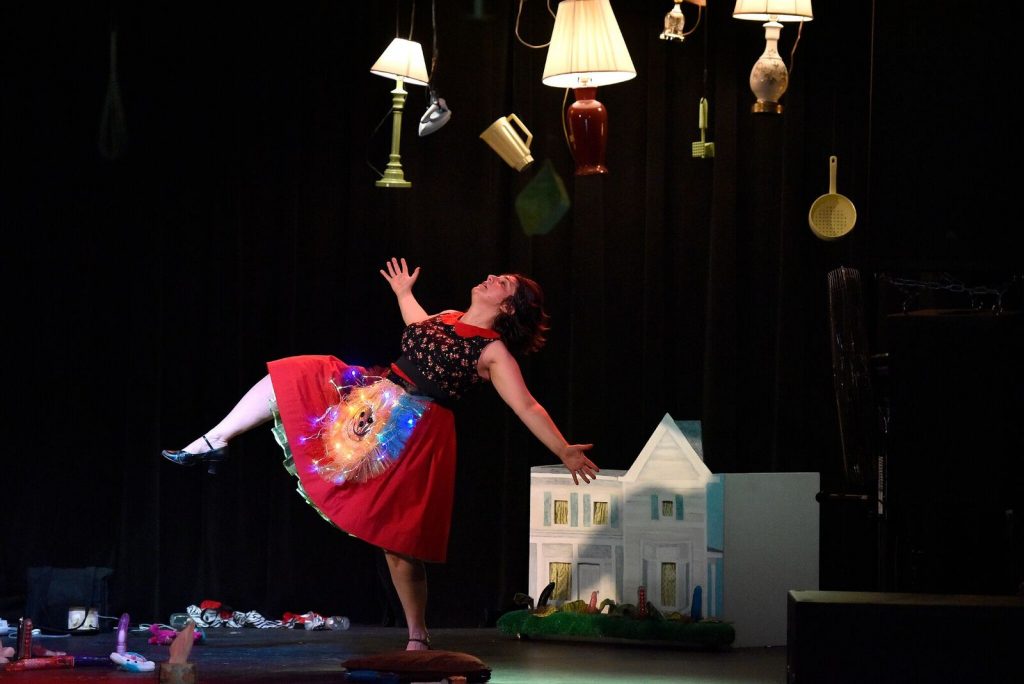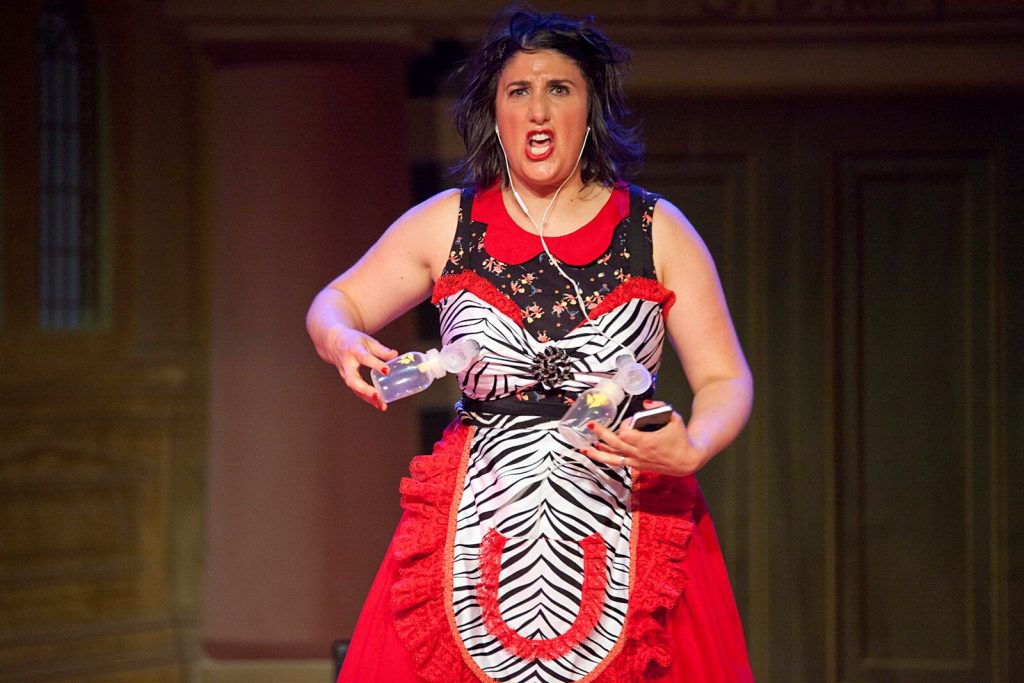Keeping the Lights On: A Conversation with Sara Juli

Photo by Grant Halverson
By Rachel Karp
What has a dozen vibrating dildos, a princess karaoke machine, and free snacks? Sara Juli’s one-woman show Tense Vagina: an actual diagnosis, of course! Since graduating from Skidmore College in 2000 with a degree in Dance and Anthropology, Sara has created ten evening-length, solo performance pieces. Sara refers to these pieces as her ‘dances,’ because the foundation of her training and her process is in dance. However, she acknowledges that the final products rarely look like dance and has come to accept ‘performance art’ as a catch-all term for what she does. She aptly describes her work as existing at “an intersection of movement, text, song, humor and audience interaction.” This past weekend, Sara returned to Skidmore College to perform her most recent piece, Tense Vagina: an actual diagnosis. “Raise your hand if you know what a kegel is,” Sara asks a sold-out crowd in the JKB, comprised of students, faculty, and members of the Saratoga community. Almost everyone raises their hands. “Okay, I’m gonna explain it to you anyway because I don’t believe you,” Sara continues. She goes on to give the audience a vivid description and demonstration of kegel exercises. For those of you who may not know, kegel-ing involves contracting and relaxing the muscles of the pelvic floor, usually to combat urinary incontinence, AKA peeing your pants.
Although she has been dancing since the age of three, Sara locates Skidmore College as the place where she discovered her method of generating work. In her senior year, Sara participated in a two-week intensive workshop led by guest artist Deborah Hay. Sara describes those two weeks as “meditative practice.” She tells us, “we basically meditated and danced for hours with candles lit illegally in the studios and it just opened a window and I found my voice.” It was during this intensive that Sara realized she needed to create work that comes from a highly personal place: a place, Sara tells me, equivalent to the diary entries you write with no intention of ever sharing with anyone else. She explains that “when [my] thoughts start to fester or some negativity comes in or I’m struggling with some aspect of something that I’m either journaling about or thinking about, it’s a trigger point that I need to make a dance about it.” The result of this process, Sara says, is a repertoire of work that “run[s] concurrently with the stages in [her] life.” She tells me, “I’ve just been crafting since graduating. Crafting, crafting. And then I paused for a full five years to have two children. Boy do they take you off course! And now I’m back on.”

Photo by Kristofer Alan Thompson
Sara created Tense Vagina: an actual diagnosis in 2015 as a means to explore what was happening to her body and mind after giving birth to her two daughters. On balancing her artistic life with her life as a mother, Sara tells me “you don’t balance, you just give your best effort.” And on motherhood alone she revealed, “I experienced post-partum depression and a lot of bodily hardships, just pushing two children out of my vagina. My vagina broke, as actually it does with everyone, we just don’t talk about it,” Sara tells me. She goes on to explain that “there is some level of trauma that happens to your body after giving birth, yet all of our attention is turned toward the child and how wonderful that is, which is great, but there’s not a lot of activity and dialogue about the status of your own body. Culturally, there is this idea of ‘Well, when are you gonna lose the baby weight?’ but there’s no ‘How’s your vagina doing?’” Because of this lack of dialogue, Sara says, “it took me four years after the birth of my second child to actually get up enough courage to tell my OBGYN that I was peeing in my pants for her to recommend the treatment for me that I never knew existed.” Having received treatment for what is technically known as post-childbirth urinary incontinence, Sara wryly tells me “I no longer pee my pants! Woohoo!”
As a self-proclaimed “narcissistic solo-performance artist,” Sara’s Tense Vagina evolved, at first, from her own need to explore these issues for herself. Yet, as is the case with all of Sara’s pieces, when she began to share Tense Vagina with audiences, she discovered many other women connected with her experience. “I always have so many women come up to me after shows and go ‘oh my god, I had the exact same experience’ or ‘you read my diary’ or ‘my bladder also doesn’t work and I just buy tons of maxi pads, thank you for giving me a hope that this is something I could get fixed,’” Sara explains.
While Sara begins creating a piece for herself, the connectivity her audiences experiences is certainly intentional. Sara leaves the house lights on for her audiences for two reasons. “One,” she says, “is logistical…I go into the audience a decent amount, I need to be able see you. But the other one that’s more interesting to me is the idea of activation. I’m not here to perform for you, to put on a show and make you laugh, although I will put on a show that will make you laugh. I’m here to engage in a space with you. You see me, but guess what– I see you.” With her work, Sara attempts to counter the “zone-out” that she frequently witnesses audiences experience when viewing traditional, proscenium theater. Watching a piece from the safety of a dark house allows you to drift off, “thinking about your day, and your grocery list, and that paper you have to write later, etc. etc.,” says Sara. “I’m trying to push past that, to see if by engaging with the audience, breaking down the fourth wall: can you just stay with me for an hour?”
At the end of our conversation, I asked Sara what advice she would give to her twenty-something self. “Wear a condom!” she says, laughing. Yet, as is the case with her work, beneath her humor is a genuine truth. “I engaged in a lot of promiscuous behavior both in college and in my twenties and I came to regret a lot of that,” she explains, “and it actually feeds into this piece which is about the care of your body and the empowerment of your body and not abusing your body. It would have been nice to sit down with my twenty-year-old self and say ‘you’re beautiful, your body is important, don’t abuse it, make strong choices, make conscious choices, and you know, just be kind. Be kind to yourself.’”
REHEARSAL PHOTO GALLERY
*This interview was edited and condensed by Ziggy Schulting ’18 & Rachel Karp ’18
***
Rachel Karp ’18 is an English/Theater double major and Co-Editor-in-Chief of the Living Newsletter.





